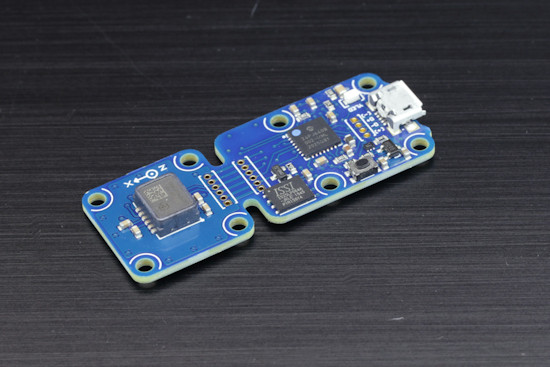![]() Some time ago, we played with Murata SCL3300 tilt sensor. During these tests, we were impressed enough by its accuracy to think that it was worth it to make it into a dedicated Yoctopuce module. Hence the Yocto-Inclinometer that we present today.
Some time ago, we played with Murata SCL3300 tilt sensor. During these tests, we were impressed enough by its accuracy to think that it was worth it to make it into a dedicated Yoctopuce module. Hence the Yocto-Inclinometer that we present today.
The Yocto-Inclinometer is a single length 20x55mm module.

The Yocto-Inclinometer
You can split the PCB into two parts to move away the sensor part, which measures only 20x20mm, which enables you to more easily mount it on mobile parts. However, you'll need a soldering iron and some skill to implement the modification: there is no pad for Picoflex connectors, so you must solder the ribbon cable directly.

You can split the Yocto-Inclinometer into two parts
Like for the Yocto-3D, you can mount the module in any position as you can configure the orientation in the module settings.
The module contains three inclinometers: the first two provide the orientation of the module with regards to the horizon, along axes X and Y. The third one provides you with the angle between the plane of the module and the vertical. In other words, if you want to know of how much your module tilts, use the third inclinometer. If you want to know in which direction it tilts, use the first two.
Accuracy
The main interest of the Yocto-Inclinometer with regards to the Yocto-3D, which also contains tilt sensors, is its accuracy. With the Yocto-Inclinometer, you can hope for an accuracy to the hundredth of degree. In fact, you have three working modes available:
- up to 90░, 1.8g: sensitivity of 0.01 degree, 40Hz
- up to 90░, 3.6g: sensitivity of 0.02 degree, 65Hz
- up to 10░, high accuracy: sensitivity of 0.005 degree, 10Hz
The low noise level in the measure is quite remarkable. We performed a small and very simple experiment: the module is stuck in a heavy mechanic's vice straddling a sheet of paper. If we pull on the sheet from under the vice, this can be seen without ambiguity in the measures.


We pull on the sheet and we look at what happens on the graph
Bonus features
On top of the three inclinometers, the Yocto-Inclinometer has a few additional features:
Accelerometer
The SCL3300 is in fact based on a 3D accelerometer, that is a set of three orthogonal accelerometers. The module publishes the acceleration values on the three axes as well as the norm of the acceleration vector undergone by the module.
Temperature sensor
As the SCL3300 compensates for temperature, it embeds an internal temperature sensor and the Yocto-Inclinometer publishes its value.
Limitations
The Yocto-Inclinometer is not however a magical tool, there are some limitations that you must understand:
- We don't guaranty the position of the zero to the hundredth of degree because first the sensor can have a slight offset, and second we cannot technically guaranty a perfect alignment when soldering the sensor on the PCB. But if there is an offset, you can easily cancel it with the calibration system present on all Yoctopuce sensors.
- If you intend to use the Yocto-Inclinometer to determine the altitude of a vehicle, remember that the sensors is based only on accelerometers. Therefore, you will obtain accurate measures only if the vehicle is dependent of no other force than gravity, in other words, only in a straight line at a constant speed.
- The module doesn't have a compass, it can't determine its horizontal orientation.
The other side of the coin
Unfortunately, there is nothing really free in this world. The SCL3300 sensor is a particularly expensive component. The costs of manufacturing the Yocto-Inclinometer is almost twice as much as that of manufacturing the Yocto-3D. This explains why we sell it at almost twice the price of the latter.


